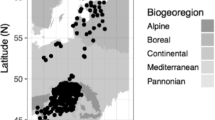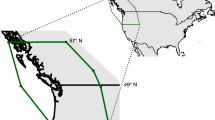Abstract
Phenological shifts linked to global warming reflect the ability of organisms to track changing climatic conditions. However, different organisms track global warming differently and there is an increasing interest in the link between phenological traits and plant abundance and distribution. Long-term data sets are often used to estimate phenological traits to climate change, but so far little has been done to evaluate the quality of these estimates. Here, we use a 73-year long data series of first flowering dates for 25 species from north-temperate Sweden to evaluate (i) correlations between first flowering dates and year for different time periods and (ii) linear regression models between first flowering date and mean monthly temperatures in preceding months. Furthermore, we evaluate the potential of this kind of data to estimate the phenological temperature sensitivities (i.e. number of days phenological change per degree temperature change, β60) in such models. The sign of the correlations between first flowering dates and year were highly inconsistent among different time periods, highlighting that estimates of phenological change are sensitive to the specific time period used. The first flowering dates of all species were correlated with temperature, but with large differences in both the strength of the response and the period(s) of the year that were most strongly associated with phenological variation. Finally, our analyses indicated that legacy data sets need to be relatively long-term to be useful for estimating phenological temperature sensitivities (β60) for inter-specific comparisons. In 10-year long observation series only one out of 24 species reached ≥80 % probability of estimating temperature sensitivity (β60) within a ±1 range, and 17 out of 24 species reached ≥80 % probability when observation series were 20 years or shorter. The standard error for β60 ranged from 0.6 to 2.0 for 10-year long observation series, and 19 out of 24 species reached SE < 1 after 15 years. In general, late flowering species will require longer time series than early flowering species.



Similar content being viewed by others
References
Abu-Asab MS, Peterson PM, Shetler SG, Orli SS (2001) Earlier plant flowering in spring as a response to global warming in the Washington, DC, area. Biodivers Conserv 10:597–612
Arft AM, Walker MD, Gurevitch J, Alatalo JM, Bret-Harte MS, Dale M, Diemer M, Gugerli F, Henry GHR, Jones MH, Hollister RD, Jonsdottir IS, Laine K, Levesque E, Marion GM, Molau U, Molgaard P, Nordenhall U, Raszhivin V, Robinson CH, Starr G, Stenstrom A, Stenstrom M, Totland O, Turner PL, Walker LJ, Webber PJ, Welker JM, Wookey PA (1999) Responses of tundra plants to experimental warming: meta- analysis of the international tundra experiment. Ecol Monogr 69:491–511
Chuine I (2000) A unified model for budburst of trees. J Theor Biol 207:337–347
Davis CC, Willis CG, Primack RB, Miller-Rushing AJ (2010) The importance of phylogeny to the study of phenological response to global climate change. Philos Trans R Soc B-Biol Sci 365:3201–3213
Dunne JA, Harte J, Taylor KJ (2003) Subalpine meadow flowering phenology responses to climate change: integrating experimental and gradient methods. Ecol Monogr 73:69–86
Ehrlén J, Münzbergova Z (2009) Timing of flowering: Opposed selection on different fitness components and trait covariation. Am Nat 173:819–830
Fitter AH, Fitter RSR (2002) Rapid changes in flowering time in British plants. Science 296:1689–1691
Hurrell JW, Kushnir Y, Ottersen G, Visbeck M (eds) (2003) The North Atlantic Oscillation: climate significance and environmental impact. American Geophysical Union
Johansson J, Jonzén N (2012) Effects of territory competition and climate change on timing of arrival to breeding grounds: a game theory approach. Am Nat 179:463–474
Memmott J, Craze PG, Waser NM, Price MV (2007) Global warming and the disruption of plant-pollinator interactions. Ecol Lett 10:710–717
Menzel A, Sparks TH, Estrella N, Koch E, Aasa A, Ahas R, Alm-Kubler K, Bissolli P, Braslavska O, Briede A, Chmielewski FM, Crepinsek Z, Curnel Y, Dahl A, Defila C, Donnelly A, Filella Y, Jatcza K, Mage F, Mestre A, Nordli O, Penuelas J, Pirinen P, Remisova V, Scheifinger H, Striz M, Susnik A, Van Vliet AJH, Wielgolaski FE, Zach S, Zust A (2006) European phenological response to climate change matches the warming pattern. Glob Chang Biol 12:1969–1976
Miller-Rushing AJ, Primack RB (2008) Global warming and flowering times in Thoreau’s concord: A community perspective. Ecology 89:332–341
Miller-Rushing AJ, Inouye DW, Primack RB (2008) How well do first flowering dates measure plant responses to climate change? The effects of population size and sampling frequency. J Ecol 96:1289–1296
Møller AP, Rubolini D, Lehikoinen E (2008) Populations of migratory bird species that did not show a phenological response to climate change are declining. Proc Natl Acad Sci USA 105:16195–16200
Parmesan C (2006) Ecological and evolutionary responses to recent climate change. Annu Rev Ecol Evol Syst 37:637–669
Parmesan C (2007) Influences of species, latitudes and methodologies on estimates of phenological response to global warming. Glob Chang Biol 13:1860–1872
Parmesan C, Yohe G (2003) A globally coherent fingerprint of climate change impacts across natural systems. Nature 421:37–42
Penuelas J, Filella I, Comas P (2002) Changed plant and animal life cycles from 1952 to 2000 in the Mediterranean region. Glob Chang Biol 8:531–544
Post E, Stenseth NC (1999) Climatic variability, plant phenology, and northern ungulates. Ecology 80:1322–1339
Quinn G, Keough M (2002) Experimental design and data analysis for biologists. Cambrdige University Press, Cambridge
Rafferty NE, Ives AR (2011) Effects of experimental shifts in flowering phenology on plant-pollinator interactions. Ecol Lett 14:69–74
Root TL, Price JT, Hall KR, Schneider SH, Rosenzweig C, Pounds JA (2003) Fingerprints of global warming on wild animals and plants. Nature 421:57–60
Shea KM, Truckner RT, Weber RW, Peden DB (2008) Climate change and allergic disease. J Allergy Clin Immunol 122:443–453
Sherry RA, Zhou XH, Gu SL, Arnone JA, Schimel DS, Verburg PS, Wallace LL, Luo YQ (2007) Divergence of reproductive phenology under climate warming. Proc Natl Acad Sci USA 104:198–202
Smith B, Samuelsson P, Wramneby A, Rummukainen M (2011) A model of the coupled dynamics of climate, vegetation and terrestrial ecosystem biogeochemistry for regional applications. Tellus 63A:87–106
Sparks TH, Tryjanowski P (2005) The detection of climate impacts: some methodological considerations. Int J Climatol 25:271–277
Sparks T, Huber K, Tryjanowski P (2008) Something for the weekend? Examining the bias in avian phenological recording. Int J Biometeorol 52:505–510
Thackeray SJ, Sparks TH, Frederiksen M, Burthe S, Bacon PJ, Bellk JR, Botham MS, Brereton TM, Bright PW, Carvalho L, Clutton-Brock T, Dawson A, Edwards M, Elliott JM, Harrington R, Johns D, Jones ID, Jones JT, Leech DI, Roy DB, Scott WA, Smith M, Smithers RJ, Winfield IJ, Wanless S (2010) Trophic level asynchrony in rates of phenological change for marine, freshwater and terrestrial environments. Glob Chang Biol 16:3304–3313
Visser ME, Both C (2005) Shifts in phenology due to global climate change: the need for a yardstick. Proc R Soc B Biol Sci 272:2561–2569
Walther GR, Post E, Convey P, Menzel A, Parmesan C, Beebee TJC, Fromentin JM, Hoegh-Guldberg O, Bairlein F (2002) Ecological responses to recent climate change. Nature 416:389–395
White MA, Running SW, Thornton PE (1999) The impact of growing-season length variability on carbon assimilation and evapotranspiration over 88 years in the eastern US deciduous forest. Int J Biometeorol 42:139–145
Willis CG, Ruhfel B, Primack RB, Miller-Rushing AJ, Davis CC (2008) Phylogenetic patterns of species loss in Thoreau’s woods are driven by climate change. Proc Natl Acad Sci USA 105:17029–17033
Wolkowich EM, Cook BI, Allen JM, Crimmins TM, Betancourt JL, Travers SE, Pau S, Regetz J, Davies TJ, Kraft NJB, Ault TR, Bolmgren K, Mazer SJ, McCabe GJ, McGill BJ, Parmesan C, Salamin N, Schwartz MD, Cleland EE (2012) Warming experiments underpredict plant phenological responses to climate change. Nature 485:494–497
Acknowledgments
We are deeply grateful to Ms Ethel Johansson, who kindly answered our questions and shared the notebook with observation data compiled by her late husband, Mr Gunnar Johansson. The Swedish Research Council supported this work by a grant to KB.
Author information
Authors and Affiliations
Corresponding author
Electronic supplementary material
Below is the link to the electronic supplementary material.
ESM 1
Variation in mean monthly morning temperatures (MMT7AM) at the phenology observation site (Gullsmyra, southern Sweden: WGS84: N 60° 7′ 34.39″, E 16° 56′ 46.81″). R- and p-values are results from correlation analyses based on the complete time period. (PDF 1394 kb)
Rights and permissions
About this article
Cite this article
Bolmgren, K., Vanhoenacker, D. & Miller-Rushing, A.J. One man, 73 years, and 25 species. Evaluating phenological responses using a lifelong study of first flowering dates. Int J Biometeorol 57, 367–375 (2013). https://doi.org/10.1007/s00484-012-0560-8
Received:
Revised:
Accepted:
Published:
Issue Date:
DOI: https://doi.org/10.1007/s00484-012-0560-8




